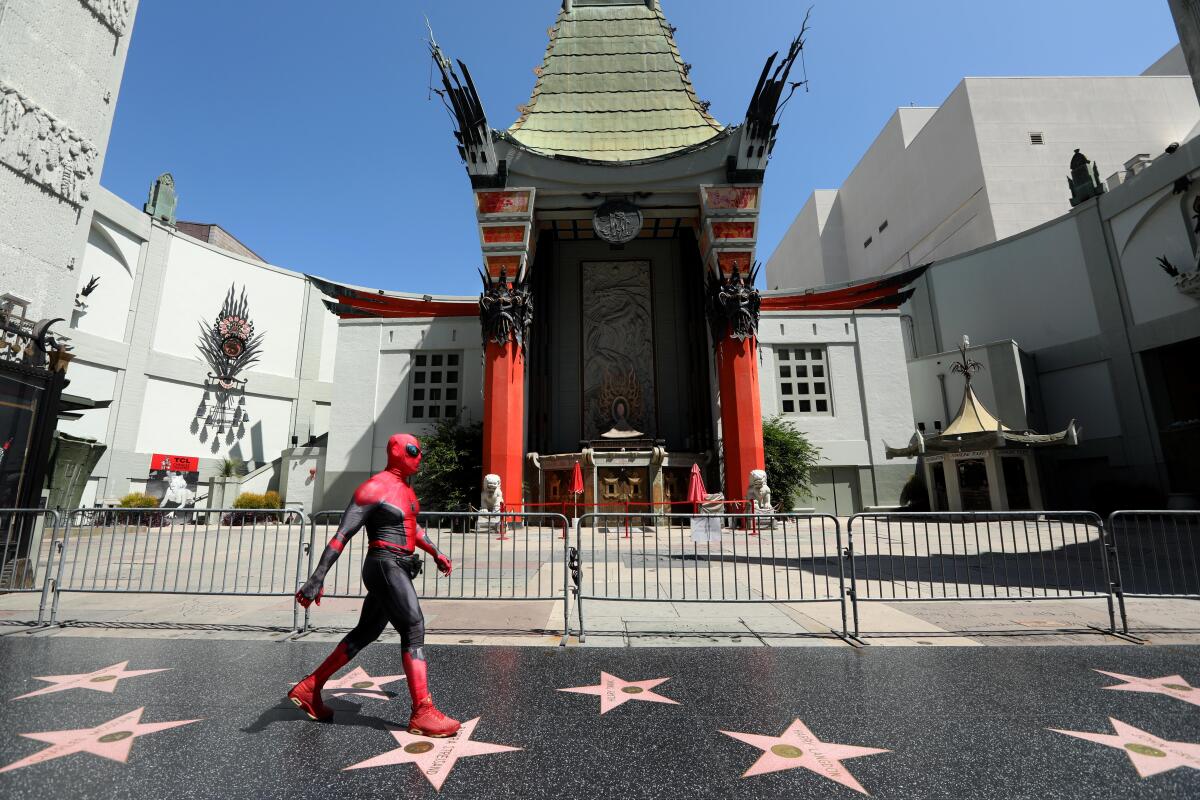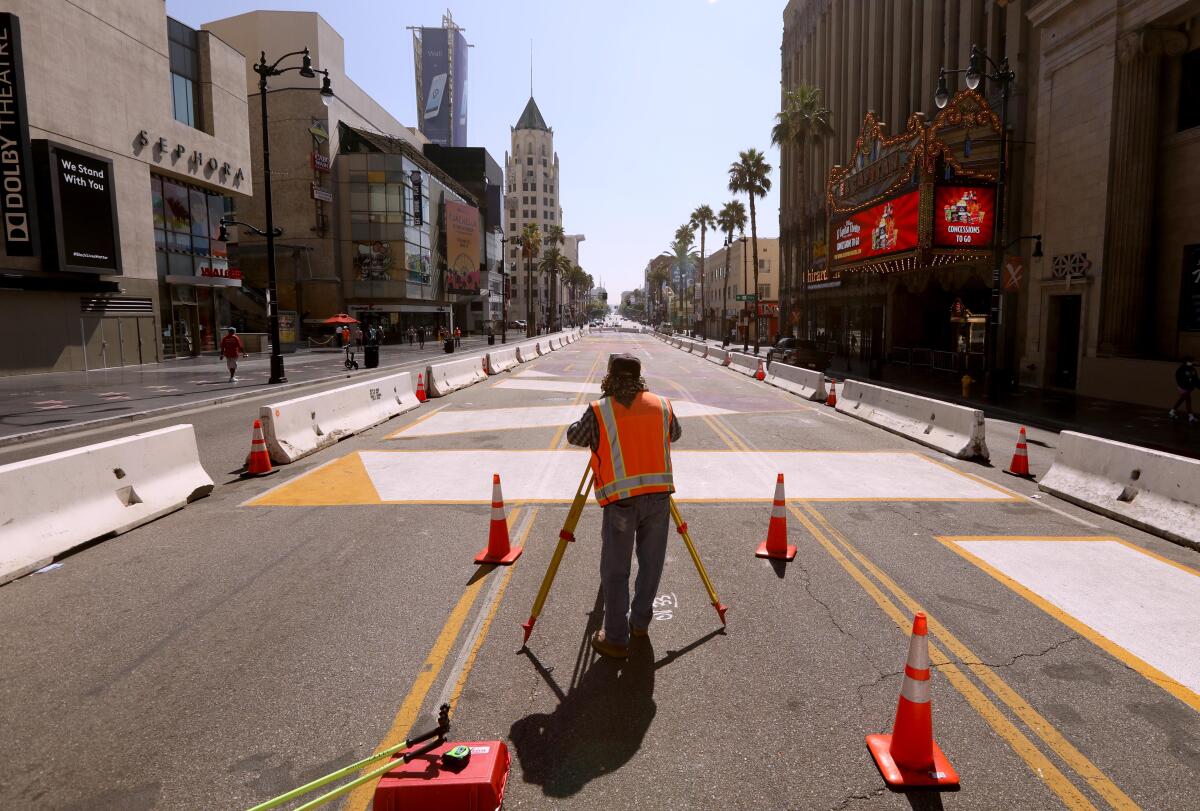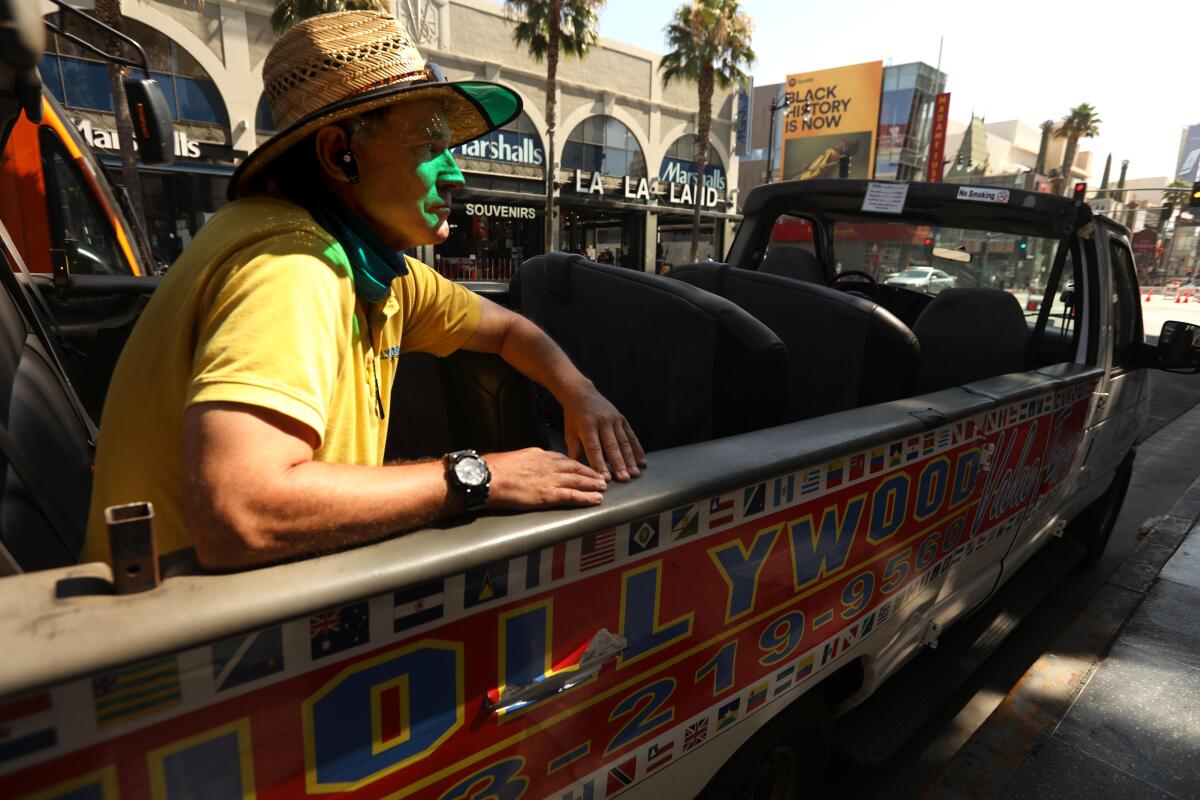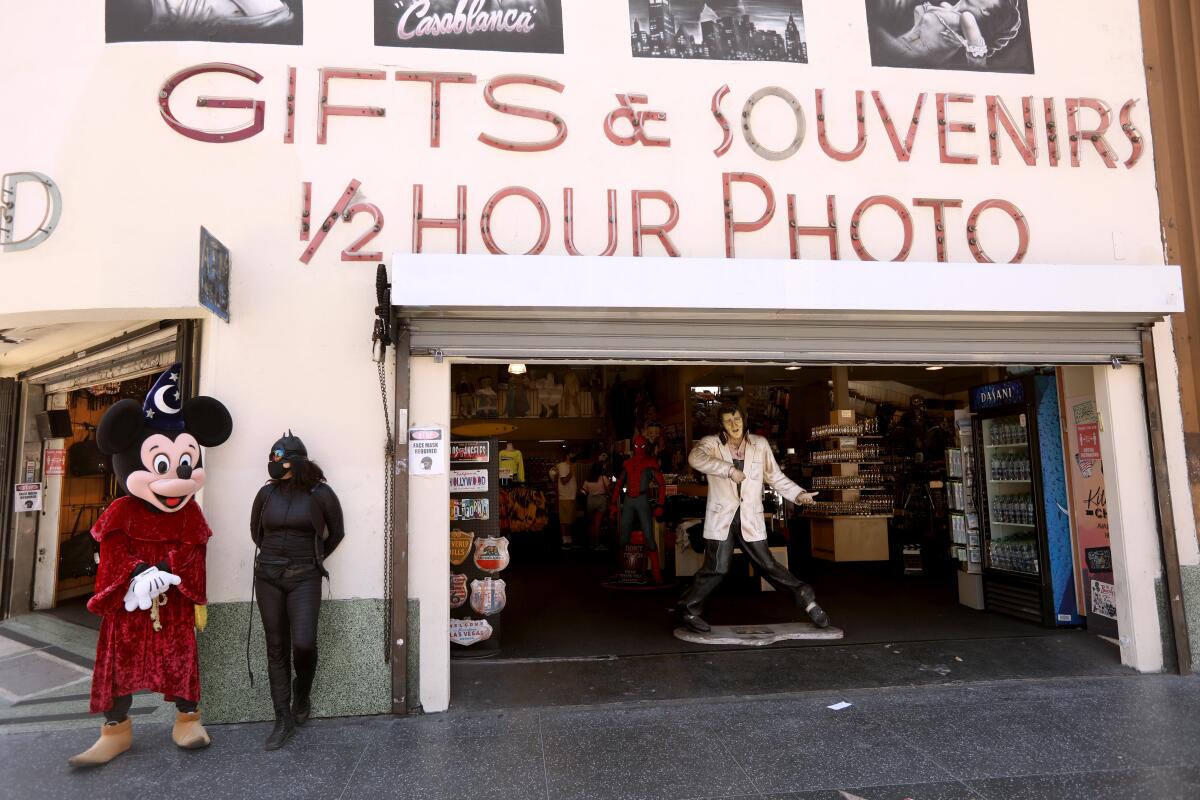Sidewalk superheroes and the rest of the Hollywood Boulevard economy are being devastated by coronavirus

- Share via
Javie Rubio, better known as the Mickey Mouse who greets pedestrians along the Hollywood Walk of Fame, stood under an awning, staring into a mostly empty street. He furrowed his brows as he thought about how much he would be able to take home for the day.
Along Hollywood Boulevard, Rubio and others dressed as cartoon characters roamed the charcoal terrazzo sidewalks, periodically extending an arm to the scattering of tourists walking by. Normally, the fist bumps he offers to entice visitors into taking a photo work like magic. But he hasn’t had much luck since the pandemic hit. Now, most people fear physical contact.
After four hours in the summer sunshine, Rubio — who sprays his costume each day with disinfectant — had $53 in his pocket. This time last year, he would return home to his wife and son with 10 times that.
“The only thing we’re trying to do now is to survive,” he said.
The coronavirus has fundamentally changed life at one of Los Angeles’ most bustling and bizarre crossroads, a place that draws millions of tourists each year. Hollywood Boulevard is the center of L.A.’s tourist economy, a place so crowded with pedestrians that the city has considered closing a stretch of the famed street to cars.
But that was before March, when businesses closed down, tourism dried up and the mantra of social distancing trumped the desire to see and be seen.
Summer is typically Hollywood Boulevard’s busy season, when tourists from around the world join locals to go to movies, nightclubs and eateries. And though the intersection of Hollywood and Highland Avenue is far from deserted, missing is the chaotic blend of street performers, tour buses, souvenir hawkers and people taking selfies in front of TCL Chinese Theatre.
With the boulevard’s entire ecosystem built around big crowds willing to mingle in close quarters, some wonder whether COVID-19 is going to permanently change a place that has been a destination of dreams for nearly a century.

While the glamour of 1940s Tinseltown may have faded, Hollywood’s busiest block has always bustled with tourists and the commerce that caters to them. Come time for a movie premiere or Oscar night, the crowd is unmatched.
Rubio could always count on being surrounded by throngs of people with money in hand to snap a quick photo. But with the block’s iconic movie theaters and museums now closed, there is little left for tourists to do.
Outside the TCL Chinese Theatre — where visitors until recently had to pay $5 to see the famed celebrity handprints and footprints set off from the sidewalk by barricades — Kevin Daysal and his wife, Yuqing Huang, were trying to briefly put aside the misfortune they’ve encountered during the pandemic.

They had made the trip from Atlanta so that Huang, 29, could get a test she needed to leave the country to seek medical attention in China.
“We’ve both lost our jobs due to COVID-19 and we don’t have health insurance,” said Daysal, 34. “We’re just trying to spend our last day together before she leaves.”
The side trip wasn’t what they expected. Most places were closed, but on the bright side, the few people populating the street made for better photos.
“At least the traffic wasn’t that bad,” Huang said.
Across the street, the blinking lights of the El Capitan Theatre shimmered off the sidewalk for few to see. Its entrance was dark. Even the giant dinosaur on the roof of Ripley’s Believe It or Not! museum wore a mask.


Outside, half of the street was blocked off to protect the “All Black Lives Matter” chalk art on the pavement. A street once lined by vendors was reduced to a single hot dog cart with a rainbow umbrella at the corner of Hollywood and Highland.
Armando Lopez, 60, prepped the bell peppers and onions, meticulously flipped the bacon-wrapped hot dogs to ensure even cooking and called out to potential customers. In the last few weeks, he’s been selling 10 hot dogs a day, if he’s lucky — one fourth of his usual sales.
Several feet away, where music from street performances once reverberated along the sidewalk, the silence was broken by the screeching escalators in the hollow blue-tiled Metro stop. Data comparing June 2019 with June 2020 at Metro’s Hollywood and Highland bus stops showed a 71% drop in ridership. Red Line ridership saw a decrease of 83%.
At noon, a drummer set up to perform a set of classic rock to a nearly empty street. The pandemic has swept away competing performers, giving him the perfect opportunity to break into the scene.
“I haven’t found anyone else who wants to do what I’m doing right now,” said Patrick Lamay, 53. “I’m just living out a dream.”
The days when double-decker sightseeing buses paraded through the palm tree-lined streets also are long gone. Only a fourth of the tour companies returned when the economy began to reopen, giving some hope to smaller operations like Hollywood Value Tours.

Owner Mohammed Jewel was the first of the two dozen touring companies to start up again. Though having less competition was favorable, not many people were patronizing his business.
Jewel cut his staff, leaving only himself, the manager and a couple of drivers. On a normal July day, he would give 16 tours. Now, the number has dwindled to two.
On top of that, he had to discount the price of his private tours to persuade people to ride.
Across the board, businesses have reported 80% revenue declines and a staggering number of furloughs and layoffs, said Hollywood Chamber of Commerce President Rana Ghadban.
“Businesses don’t know what to expect. It’s the uncertainty of not knowing what’s going to happen and how to comply,” she said.
Some stores rehired employees when they were able to reopen, but cut them once more when Gov. Gavin Newsom ordered a second lockdown of California.

Britney Hernandez, a manager for Souvenirs of Hollywood and the Hollywood Experience, has kept her stores open but said she fears for her safety.
“The people that do come, the few tourists, don’t follow safety precautions in the store,” Hernandez said. “It’s really concerning because we want to move forward, but I still get angry customers yelling at me for asking them to wear a mask.”
Hernandez’s kitsch souvenir shop, which touts $5 T-shirts and 99-cent magnets, was used to the ebb and flow of foot traffic, but nothing compared to this.
“It’s a ghost town here,” she said.
But until tourists return, the show must go on.
More to Read
Sign up for Essential California
The most important California stories and recommendations in your inbox every morning.
You may occasionally receive promotional content from the Los Angeles Times.











